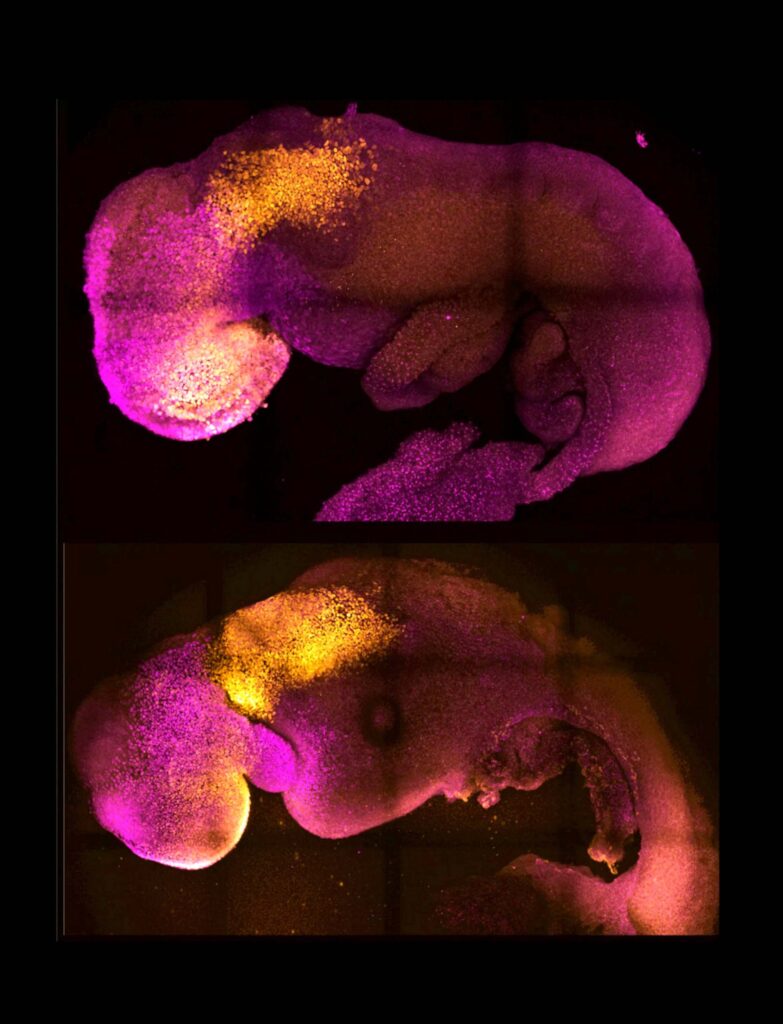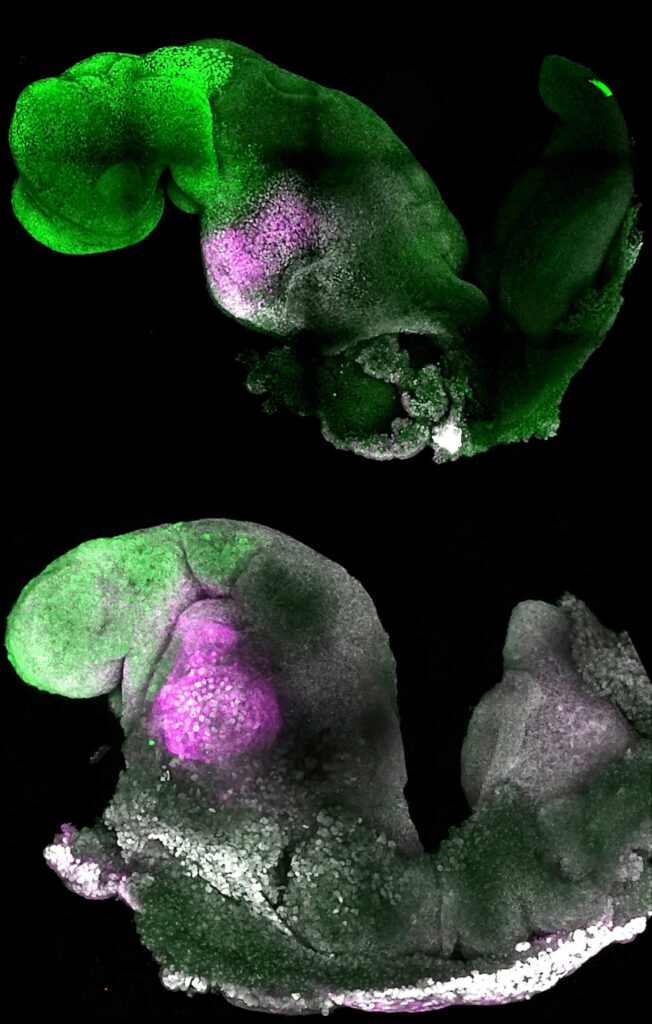A ‘synthetic’ embryo with a brain and beating heart has been created by British scientists.
It features the foundations of all the body’s organs – including neural and gut tubes that protect the developing spine and intestines.
The ‘world first’ could solve the donor shortage crisis – and prevent miscarriages. It will also reduce animal experimentation.
Cambridge University researchers used a combination of stem cells from mice – without fertilsed eggs or sperm.
Lead author Professor Magdalena Zernicka-Goetz said: “Our mouse embryo model not only develops a brain, but also a beating heart, all the components that go on to make up the body.
“It’s just unbelievable that we’ve got this far. This has been the dream of our community for years, and major focus of our work for a decade and finally we’ve done it.”

It started to grow muscles, a gut and nervous system – shedding fresh light on how tissues form and the causes of genetic diseases.
Succesful pregnancies need a ‘dialogue’ between an embryo and mother. In the first week after fertilisation, three types of stem cells develop.
One will eventually become the tissues of the body. The others support the embryo’s development.
They become the placenta, which connects the foetus to the mother and provides oxygen and nutrients, and the yolk sac, where the embryo gets its nutrients and grows.
Each group has to send mechanical and chemical signals to each other – telling the embryo how to develop properly.
Prof Zernicka-Goetz said: “So many pregnancies fail around this time, before most women realise they are pregnant.
“This period is the foundation for everything else that follows in pregnancy. If it goes wrong, the pregnancy will fail.”
The researchers mimicked natural processes in the lab by guiding three types of stem cells found in early mammalian development to the point where they start interacting.
Inducing the expression of a particular set of genes and establishing a unique environment got them to ‘talk’ to each other.
The model copies the stages of natural mouse embryo development that take place up to eight-and-a-half days after fertilisation.
Over the past decade, Prof Zernicka-Goetz’s group has been studying these initial stages in order to understand why pregnancies can go wrong.
She said: “The stem cell embryo model is important because it gives us accessibility to the developing structure at a stage that is normally hidden from us due to the implantation of the tiny embryo into the mother’s womb.
“This accessibility allows us to manipulate genes to understand their developmental roles in a model experimental system.”

They sparked development of their synthetic embryo by weaving together different cultured stem cells.
They represented each of the three types of tissue in the right proportions and environment to promote growth and communication.
After self-assembling into an embryo the researchers found they signalled chemically, mechanistically and through touch.
Prof Zernicka-Goetz said: “This period of human life is so mysterious, so to be able to see how it happens in a dish – to have access to these individual stem cells, to understand why so many pregnancies fail and how we might be able to prevent that from happening – is quite special.
“We looked at the dialogue that has to happen between the different types of stem cell at that time – we’ve shown how it occurs and how it can go wrong.”
A major advance is the ability to generate the entire brain, in particular the anterior – a big goal in the development of synthetic embryos.
In Prof Zernicka-Goetz’s system this part requires messages from one of the extra-embryonic tissues to be able to develop.
She said: “This opens new possibilities to study the mechanisms of neurodevelopment in an experimental model.
“In fact, we demonstrate the proof of this principle in the paper by knocking out a gene already known to be essential for formation of the neural tube, precursor of the nervous system, and for brain and eye development.
“In the absence of this gene, the synthetic embryos show exactly the known defects in brain development as in an animal carrying this mutation.
“This means we can begin to apply this kind of approach to the many genes with unknown function in brain development.”
The researchers are now developing similar human models with the potential to be directed towards the generation of specific organ types to understand mechanisms behind crucial processes that would be otherwise impossible to study in real embryos.
At present, UK law permits human embryos to be studied in the laboratory only up to the 14th day of development.
The findings in Nature could lead to the development of synthetic organs for patients awaiting transplants.
Prof Zernicka-Goetz added: “There are so many people around the world who wait for years for organ transplants.
“What makes our work so exciting is that the knowledge coming out of it could be used to grow correct synthetic human organs to save lives that are currently lost.

“It should also be possible to affect and heal adult organs by using the knowledge we have on how they are made.
“This is an incredible step forward and took ten years of hard work of many of my team members – I never thought we’d get to this place. You never think your dreams will come true, but they have.”
The creation of ‘synthetic’ human embryos is outside of the legal framework of the UK’s Human Fertilisation and Embryology Act.
But it would be unlawful to use them to establish a pregnancy in a woman, because they are not classed as “permitted embryos.”
Story By: Simona Kitanovska, Sub-Editor: Martin M Barillas, Agency: Zenger News
The Ananova page is created by and dedicated to professional, independent freelance journalists. It is a place for us to showcase our work. When our news is sold to our media partners, we will include the link here.




